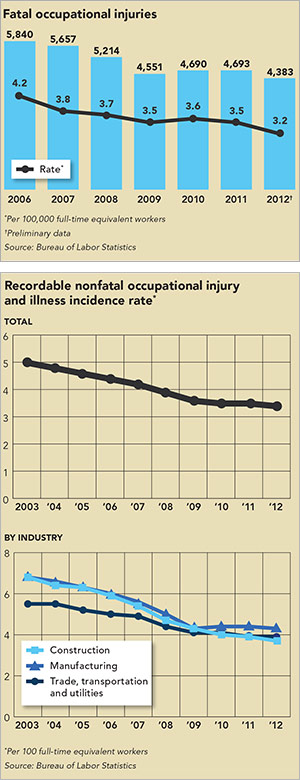2014 State of Safety
How do budget cuts and federal government shutdowns affect OSHA’s role in workplace safety?

Bottom left photo courtesy of J. J. Keller & Associates Inc.
Budget cuts
Many of OSHA’s compliance assistance programs, as well as its ability to work collaboratively with businesses, may be compromised in today’s budgetary climate, in which cuts have hit the agency’s bottom line. And more could be on the way.
“It doesn’t help that collaborative partnership,” Wood said. “If you’ve got cuts here and there, you’re not going to be able to reach the appropriate people to have those efforts continue in a meaningful way.”
Any enforcement agency is hurt by budget cuts, according to Newquist, and cuts to OSHA affect its ability to perform outreach. The alliances and partnerships the agency maintains require travel, and travel dollars may not be available under budget reductions, he said.
When the 2013 sequester went into effect, OSHA had to cut $28 million from its overall budget. In an effort to maintain funding for its enforcement programs, the administration opted to reduce compliance assistance funding by $14.8 million – $11 million more than the 5 percent sequester cut would have removed. To some stakeholders, this was a controversial move.
Newquist called compliance assistance “an important component,” adding that the agency should have sought an equal balance between it and enforcement.
In contrast, Van Houten asserted that dollars needed to be shifted to enforcement because ensuring egregious violators are held accountable is one of the principal reasons OSHA exists. If OSHA does not do it, he said, no one else will.
Although federal OSHA is able to shift its money around amid funding cuts, State Plan programs are not as fortunate. Instead of receiving a lump sum, OSHA State Plans are given money specifically earmarked for enforcement or for consultation, according to Tongate, who chairs the Occupational Safety and Health State Plan Association.
“We try to address as many workplaces as we can,” Tongate said. “With budget cuts, that number’s going to be lower than what it would be if we were fully funded.”
Additionally, he said that when State Plan budgets are cut, state programs cannot provide as much training to compliance officers or consultants as they would like. So both quantity and quality are affected.
Budget shortfalls go beyond the recent sequester. Although OSHA has received more generous increases to its budget under President Barack Obama than during the previous administration, the past two years saw funding for the agency remain static because of the passage of continuing resolutions – meaning Congress could not agree on a new budget, so it simply approved the funding levels from previous years.
“I think OSHA does a good job with the resources they have,” Newquist said. “They would probably do better if they had more money, but that’s everybody.”
Can OSHA be effective despite budget cuts? Newquist thinks so. Even with the cuts and reductions the agency has dealt with so far, OSHA is capable of tackling emerging issues, he said, noting recent efforts the agency has made regarding the safety of temporary workers.
Not everyone is as optimistic. Tongate suggested that any cuts to OSHA – and subsequently to the State Plan programs – will hurt worker safety. Without a strong enforcement program, he said, the number of employers who do not take responsibility for providing a safe work environment could grow.
“It’s hard to put a number on the impact, but obviously things that the OSHA programs across the country do is to protect workers,” Tongate said. “When you cut back on programs that we enforce and implement, it’s going to have an impact.”

Effects of the shutdown
Budget cuts were pushed to the extreme in October 2013. During the past couple of years, shutdowns were averted by an agreement and continuing resolution to keep the federal government running.
However, no last-minute save occurred this past Sept. 30, when the government’s fiscal year ended. When no agreement was reached, the federal government underwent a partial shutdown in which “non-essential” services ceased operations for 16 days. The vast majority of OSHA operations stopped. Routine inspections were not conducted, and the agency responded only to imminent hazards, deaths and catastrophes.
Newquist is convinced workers got hurt because of the shutdown. “OSHA sometimes is the only thing between death on the job and safety,” he said. “For every hazard, you’re going to have so many injuries, and those injuries could have been prevented if OSHA was out there.”
Consultation services also stopped during the shutdown. This severely affected the State Plan states, which receive up to 90 percent of their consultation funding from the federal government.
“When people are asking for help and you can’t provide it, that’s concerning,” Tongate said.
Fortunately, Tongate said, state agencies will be able to catch up on the missed inspections – and New Mexico, at least, will be able to make up the missed consultation visits.
Van Houten was less sure federal OSHA would be able to tackle its 16-day backlog of inspections. “There was a three-week period they were shut down, they didn’t get those inspections done, and there’s no way to replace them,” Van Houten said.
The shutdown and ongoing fights about the debt ceiling take away the opportunity to address pro-growth policies, according to the National Association of Manufacturers, which asserts such policies benefit employers and employees.
“Those types of things aren’t good for anybody. It’s not good to have those types of activities or conflicts going on,” Wood said, regarding the shutdown and sequestration. While an agreement was reached between Congress and the president to end the shutdown, it is short-lived. The current continuing resolution only funds the government through Jan. 15, 2014. If a funding agreement is not reached by that date, another government shutdown will occur. At press time, a bipartisan budget agreement had passed the House and awaited a vote in the Senate, but specific department funding levels were not yet agreed on.
Occupational deaths and injuries continued their downward trend in 2012, according to the most recent data from the Bureau of Labor Statistics.
Preliminary figures showed 4,383 fatal work injuries occurred in 2012, with 3.2 injury deaths per 100,000 full-time equivalent workers. This is a drop from the 2011 finalized figures of 4,693 and a rate of 3.5.
This is the second lowest preliminary total since the BLS Census of Fatal Occupational Injuries began in 1992. Typically, the preliminary figure is revised upward between 2 and 5 percent.
Nonfatal injury and illness rates hit an all-time low in 2012, with BLS data reporting a rate of 3.4 injuries or illnesses per 100 full-time workers. With the exception of 2010 to 2011, nonfatal occupational injuries and illnesses have been declining every year for a decade.
The rate of nonfatal injuries and illnesses requiring days away from work also decreased in 2012 – 112 per 10,000 ?full-time private, state and local government workers, down from 117 in 2011.
Some stakeholders have attributed the downward trend of fatal and nonfatal workplace injuries to OSHA’s impact. According to John Newquist, an Illinois-based consultant and former OSHA assistant regional administrator, on-the-job deaths were on the rise before OSHA was instituted.
“I don’t think that trend would have stopped going up if there wasn’t an OSHA,” he said.
Other stakeholders are less inclined to give OSHA so much credit for the decrease in occupational fatalities, injuries and illnesses. Although the agency has played a role, so have employers, according to Amanda Wood, director of labor and employment policy at the National Association of Manufacturers.
“I think those numbers show business’s commitment to a safe workplace,” Wood said.

